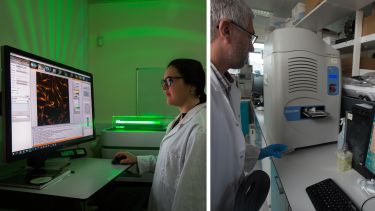Drug Discovery Suite
As part of its translational research strategy, SITraN has established a drug screening laboratory with state-of-the-art equipment to undertake a comprehensive drug discovery programme for neurodegenerative disorders.
Mr. John Greenwood (1950-2008)
The SITraN Drug Screening Laboratory is associated with Mr John Greenwood who refused to let Motor Neurone Disease destroy his zest for life.
Mr Greenwood strongly believed that science, given time and investment, would deliver a treatment.
Facilities
Our equipment allows optimized storage of our test drugs and compounds in a fully automated system using dry nitrogen. High-throughput liquid dispensing systems allow large-scale screening experiments to be conducted rapidly and with minimal, and thus most efficient, use of the test compounds.
With our automated plate readers, InCell 2000, Opera Phenix and Metabolic Analysis equipment we can further test the effects of the drugs on mitochondrial function, protein distribution, as well as cell size and shape (morphology). The Opera Phenix (see below) is our most recent acquisition and this extends the level of detail we can capture, taking our high content screening potential (previously just the InCell 2000) to new levels.
We screen compound libraries that contain FDA-approved drugs and plant extracts for neuroprotective effects and re-purposing of safe drugs. Our hits are also used for proof of concept, validating our targets. We further screen novel compounds and potential therapies developed in our own laboratories.
Collaboration
We collaborate with partners from the industry (currently Astra Zeneca UK, to test novel drugs for therapeutic potential in the treatment of neurodegenerative disorders on a range of established disease models from cell line reporter models (e.g. Nrf2 activation) to human skin cells (fibroblasts) to zebrafish.
For collaborations and pricing information for using the drug screening facility, please contact Adrian Higginbottom (a.higginbottom@sheffield.ac.uk) for further details.
Laboratory equipment
Roylan Multi-pod Storage System
This system enables our drug libraries to be stored in optimal conditions, avoiding the need for the compounds to be frozen. This minimises the risk of precipitation and degradation through repeated freeze-thaw cycles.
The system is fully automated and uses dry inert nitrogen gas to remove oxygen and humidity from the system, thus reducing potential damage to the test drugs. Storing the drug libraries in this manner extends the life of the compounds.
Labcyte Echo 650
This liquid dispensing system which uses sonic technology to dispense very small volumes (2.5 nanolitres, approximately a millionth of a teaspoon) of compounds from our drug libraries. The system is efficient and economical as it requires no plastic consumables, thus reducing the risk of contamination and loss during screening experiments.
The system can perform drug dose-response experiments in real-time and is used for compound library management as it can measure the volume and quantify the water content of the compounds being tested.
Thermo Scientific Matrix Plate Mate Plus
This high throughput liquid dispensing system is time efficient, accurate (0.1-300µl) and enables reproducibility and use of standardized operating protocols. This machine supports large-scale screening experiments to be conducted with minimal resource use. It complements the acoustic system by being fast and accurate at the repetitive dispensing of microliter volumes.
Agilent Seahorse XFe96 Analyzer
This system measures the oxygen consumption and extracellular acidification rate of live cells, giving us key indicators of mitochondrial respiration and glycolysis as well as ATP production rate. Together these measurements provide a systems-level view of cellular metabolic function in cultured cells and ex vivo samples.
The Agilent Seahorse XFe96 Analyzer uses a 96-well plate format with a 2.8ul chamber volume.
The cell samples can then be further tested in other experiments allowing measurement of metabolic activity and morphology on the same sample.
GE Healthcare InCell Analyser 2000
This high-content screening machine combines the strengths of an automated plate reader with a high-power microscope. This enables assay quantification through fluorescence spectroscopy and scrutiny of individual cell morphology. The system measures multiple parameters, providing in-depth data on the molecular and metabolic interactions being studied.
Revvity Opera Phenix and Operetta CLS
These high-content screening machines have all the attributes of the InCell 2000 above but have the added bonus of confocality. Confocality means the light is focused as well as the objective image allowing the detection of smaller biology, essential for identifying some of the most recently identified pathological hallmarks in MND. The Opera Phenix also has two cameras and lasers for simultaneous image detection, decreasing capture time, and increasing our throughput and micro lenses in the spinning disk to allow weak samples to still be detected. The Operetta is confocal, but has LEDs for emission and a single camera.
BMG Fluostar, pherastar and Clario and MSD SQ120 platereaders
These platereaders give us a wide range of absorbance, fluorescent and luminescent readings in many multiwell formats. The MSD SQ120 technology gives us unparalleled sensitivity for a range of translational biomarker assays.
We also have bulk liquid dispensers for cell plating and backfilling plates.

